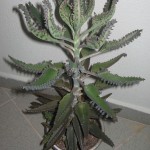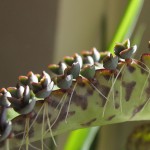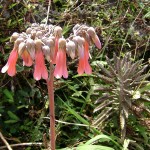Family: Crassulaceae
Synonymous: Kalanchoe daigremontiana
Distribution and habitat: Bryophyllum daigremontianum is a succulent perennial plant native to the Fiherenana River valley and Androhibolava mountains in southwest Madagascar. It has been introduced to numerous tropical and subtropical regions, such as Florida, Puerto Rico, Hawaii, parts of the Canary Islands and Australia. Like other members of the genus Bryophyllum, it is able to propagate vegetatively from plantlets (epiphyllous buds) that develop on the leaf edges. The plantlets that grow on the edges of each leaf fall easily and root wherever they land.
It is commonly found growing on gravelly and sandy soils. This succulent plant is a weed of bushland and disturbed sites such as roadsides, along fence lines, around rubbish tips and abandoned rural dwellings. It also occurs frequently along creeks and rivers where it is spread by floodwaters.
Description: Bryophyllum daigremontianum grows from a single unbranched stem 45-90cm (18-35 inch) tall, which carries opposite pairs of fleshy, shiny, lance-shaped leaves that are 10-25cm (4-10 inch) long. The leaves grow at an 8 angle to the stem and are bluish green with purple blotched undersides. The saw-toothed leaf edges curl slightly inward. The tiny plantlets that form in the gaps between the teeth often have tiny aerial roots attached. One leaf can carry as many as 50 such plantlets in a single season. Pink flowers, which bloom only on mature plant, are roughly tubular, 2cm (0.8 inch) long and pendent. They are carried in rather flat clusters at the top of 30cm (12 inch) tall stalks in late autumn and early winter. The plant dies after blooming. Flowering is, however, not an annual event and will occur sporadically if at all. Particularly in climates with distinct seasonal temperature differences, flowering is most frequently observed at the beginning of a warm season.
Bryophyllum daigremontianum take a year or two to mature.
Houseplant care: Bryophyllum daigremontianum requires minimal care and can tolerate dry conditions and high temperatures. It is an unusual, fast growing succulent.
Light: These plants like bright light; do not subject them to direct sunlight.
Temperature: Bryophyllum daigremontianum thrive in normal room temperature.
Watering: During the active growth period water moderately, but allow the top centimetre (0.4 inch) or so of the potting mixture to dry out between waterings. In the rest period water sparingly.
Feeding: Apply standard liquid fertiliser once a month during the active growth period.
Potting and repotting: Use a soil based potting mixture. Move small plants into pots one size larger every spring. A Bryophyllum daigremontianum big enough to need 15cm (6 inch) pot is usually unshapely and best discarded.
Gardening: Bryophyllum daigremontianum is not frost-hardy and typically dies if subjected to temperatures below freezing. Within its hardiness zone, Bryophyllum daigremontianum have the potential to escape from cultivation and spread into natural environments becoming a problematic weed. Therefore, precaution have to be taken when grow these plants in garden.
Newly transplanted Bryophyllum daigremontianum have the tendency to wilt. It is recommended to stake the taller ones to keep them growing straight until their roots are reestablished; these plants can be also planted deeper than the original root to give more support and promote more root growth. They will soon resume their growth.
Position: Plant Bryophyllum daigremontianum in full sun or partial shade. Leaves will develop a pinkish-red colour with lots of light, or will stay a greener coluor under less bright conditions.
It is very heat resistant, if planted in shade.
Soil: Bryophyllum daigremontianum thrive in well draining, sandy soil. The plants establish well in leaf litter or other debris on shallow soils.
Space the plants 15-25cm (610 inch) apart to make room for the leaves to display their plantlets.
To promote new plants, do not mulch the ground around Bryophyllum daigremontianum. The plantlets which loosen from the plant will grow much better if allowed to fall directly onto soil rather than onto mulch.
Irrigation: Water well when plant the Bryophyllum daigremontianum. After that these plants can be neglected or if watered, do so no more than once or twice a week. These succulent plants are adapted to dry conditions and can survive long periods of drought.
Fertilising: Use a water soluble fertiliser on Bryophyllum daigremontianum plants, following the directions given by the manufacturer.
Propagation: Plantlets growing at the base of the plants may be dug up at any time, replanted in 5-8cm (2-3 inch) pots of standard potting mixture and treated as mature plants. Or plantlets may be picked from the leaves and shallowly planted in standard potting mixture.
Problems: Bryophyllum daigremontianum is generally problem free, but their succulent leaves are a great attraction for insects like mealy bugs, scale or aphids.
Treatment: Control mealy bugs by wiping the infested leaves with a cotton swab dipped in alcohol. Remove brown scale insects by gently scraping them off. Aphids should be removed by hand. Isolate plants that show signs of insect pest infestation to prevent infestation of other plants.
Prune tall growth and old flower stems and allow plenty of air flow around your plant to avoid powdery mildew.
Treatment: If the plant becomes infected with powdery mildew, potassium bicarbonate can be used to control it.
If rot affects the plant, it normally starts at the root.
Treatment: It is recommended to discard affected plants and start new ones fromplantlets.
Toxicity: All parts of the Bryophyllum daigremontianum plant are poisonous (they contain daigremontianin and other bufadienolides), which can even be fatal if ingested by infants or small pets. It is also poisonous to humans.
Note: Bryophyllum daigremontianum is a widespread weed of pastures, grasslands, open woodlands, waste areas, disturbed sites, fence lines, roadsides, embankments, and railways in subtropical, semi-arid, tropical and warmer temperate regions. It is commonly found growing in rocky sites or on poor soils. It prefers rocky outcrops in dry savannas and urban open spaces.
Bryophyllum daigremontianum has been introduced to many parts of the world as an ornamental plant. However, these uses cannot compensate for this plant's overall negative impacts.
Uses and display: Bryophyllum daigremontianum is more ideal for container growing than landscape planting because it can be difficult to control in outdoor gardens. Both, its unusual leaves which carry the plantlets and its tubular cluster of flowers have ornamental value. Arranged with other succulents, Bryophyllum daigremontianum makes a lovely desert window sill planter. It is a great looking as specimen plant as well as mass planting or group planting.
Bryophyllum daigremontianum is growing in shallow rocky soils, so it is an excellent plant for rocky gardens and xeriscaping.
SUMMARY:
CHARACTERISTICS:
Foliage green
Features flowers
Shape upright
Height: 90-120cm (36-48 inch)
PROPER CARE:
Watering in rest period sparingly
Watering in active growth period moderately
Light bright
Temperature in rest period min 16C max 24C (61-75F)
Temperature in active growth period min 16C max 24C (61-75F)
Humidity low
Hardiness zone: 9b-11





